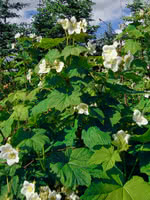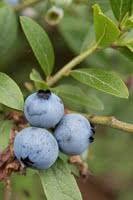Mon-Fri 9am - 5pm Mountain time
Thimbleberry vs Lowbush Blueberry
Rubus parviflorus
Vaccinium angustifolium
NOT AVAILABLE THIS SEASON - MIGHT RETURN
Thimbleberry is an ornamental shrub with large, green maple-like-leaves. Flowers are attractive, fragrant, and turn into red-raspberry-like berries. The berries are good for jams, cakes, breads, muffins etc. If you remove the berry, the core resembles a thimble, giving this shrub its namesake.
Lowbush Blueberry, commonly known as the Wild Lowbush Blueberry, is often wild-harvested and thrives in low pH acidic soil. This early low-bush blueberry produces white and pink bell-shaped flowers in the spring. Its fruit is smaller in size than high bush blueberry plants and is more flavourful with an intense blueberry taste-masking it perfect for fresh eating, baking, and preserves.
Note: Blueberries require very specific soil conditions. They need well-drained soil with a pH between 4.5 and 5.0. If the starting pH of your soil is between 5.1 and 6.2 you can lower it by adding sulfur. We recommend against planting blueberries in soil with a starting pH greater than 6.2. Please do your own research before buying any blueberry plants.

